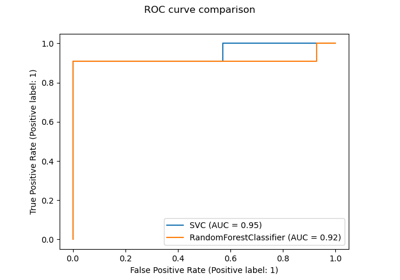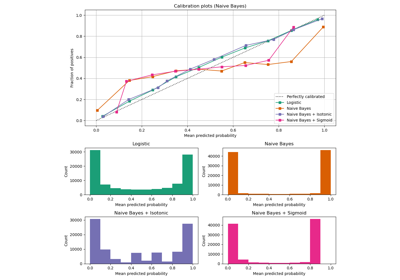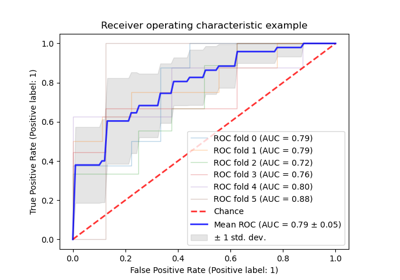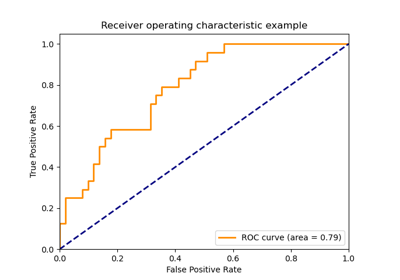sklearn.metrics.roc_auc_score¶
- sklearn.metrics.roc_auc_score(y_true, y_score, *, average='macro', sample_weight=None, max_fpr=None, multi_class='raise', labels=None)[source]¶
Compute Area Under the Receiver Operating Characteristic Curve (ROC AUC) from prediction scores.
Note: this implementation can be used with binary, multiclass and multilabel classification, but some restrictions apply (see Parameters).
Read more in the User Guide.
- Parameters
- y_truearray-like of shape (n_samples,) or (n_samples, n_classes)
True labels or binary label indicators. The binary and multiclass cases expect labels with shape (n_samples,) while the multilabel case expects binary label indicators with shape (n_samples, n_classes).
- y_scorearray-like of shape (n_samples,) or (n_samples, n_classes)
Target scores.
In the binary case, it corresponds to an array of shape
(n_samples,). Both probability estimates and non-thresholded decision values can be provided. The probability estimates correspond to the probability of the class with the greater label, i.e.estimator.classes_[1]and thusestimator.predict_proba(X, y)[:, 1]. The decision values corresponds to the output ofestimator.decision_function(X, y). See more information in the User guide;In the multiclass case, it corresponds to an array of shape
(n_samples, n_classes)of probability estimates provided by thepredict_probamethod. The probability estimates must sum to 1 across the possible classes. In addition, the order of the class scores must correspond to the order oflabels, if provided, or else to the numerical or lexicographical order of the labels iny_true. See more information in the User guide;In the multilabel case, it corresponds to an array of shape
(n_samples, n_classes). Probability estimates are provided by thepredict_probamethod and the non-thresholded decision values by thedecision_functionmethod. The probability estimates correspond to the probability of the class with the greater label for each output of the classifier. See more information in the User guide.
- average{‘micro’, ‘macro’, ‘samples’, ‘weighted’} or None, default=’macro’
If
None, the scores for each class are returned. Otherwise, this determines the type of averaging performed on the data: Note: multiclass ROC AUC currently only handles the ‘macro’ and ‘weighted’ averages.'micro':Calculate metrics globally by considering each element of the label indicator matrix as a label.
'macro':Calculate metrics for each label, and find their unweighted mean. This does not take label imbalance into account.
'weighted':Calculate metrics for each label, and find their average, weighted by support (the number of true instances for each label).
'samples':Calculate metrics for each instance, and find their average.
Will be ignored when
y_trueis binary.- sample_weightarray-like of shape (n_samples,), default=None
Sample weights.
- max_fprfloat > 0 and <= 1, default=None
If not
None, the standardized partial AUC [2] over the range [0, max_fpr] is returned. For the multiclass case,max_fpr, should be either equal toNoneor1.0as AUC ROC partial computation currently is not supported for multiclass.- multi_class{‘raise’, ‘ovr’, ‘ovo’}, default=’raise’
Only used for multiclass targets. Determines the type of configuration to use. The default value raises an error, so either
'ovr'or'ovo'must be passed explicitly.'ovr':Stands for One-vs-rest. Computes the AUC of each class against the rest [3] [4]. This treats the multiclass case in the same way as the multilabel case. Sensitive to class imbalance even when
average == 'macro', because class imbalance affects the composition of each of the ‘rest’ groupings.'ovo':Stands for One-vs-one. Computes the average AUC of all possible pairwise combinations of classes [5]. Insensitive to class imbalance when
average == 'macro'.
- labelsarray-like of shape (n_classes,), default=None
Only used for multiclass targets. List of labels that index the classes in
y_score. IfNone, the numerical or lexicographical order of the labels iny_trueis used.
- Returns
- aucfloat
See also
average_precision_scoreArea under the precision-recall curve.
roc_curveCompute Receiver operating characteristic (ROC) curve.
RocCurveDisplay.from_estimatorPlot Receiver Operating Characteristic (ROC) curve given an estimator and some data.
RocCurveDisplay.from_predictionsPlot Receiver Operating Characteristic (ROC) curve given the true and predicted values.
References
- 1
- 2
- 3
Provost, F., Domingos, P. (2000). Well-trained PETs: Improving probability estimation trees (Section 6.2), CeDER Working Paper #IS-00-04, Stern School of Business, New York University.
- 4
Fawcett, T. (2006). An introduction to ROC analysis. Pattern Recognition Letters, 27(8), 861-874.
- 5
Examples
Binary case:
>>> from sklearn.datasets import load_breast_cancer >>> from sklearn.linear_model import LogisticRegression >>> from sklearn.metrics import roc_auc_score >>> X, y = load_breast_cancer(return_X_y=True) >>> clf = LogisticRegression(solver="liblinear", random_state=0).fit(X, y) >>> roc_auc_score(y, clf.predict_proba(X)[:, 1]) 0.99... >>> roc_auc_score(y, clf.decision_function(X)) 0.99...
Multiclass case:
>>> from sklearn.datasets import load_iris >>> X, y = load_iris(return_X_y=True) >>> clf = LogisticRegression(solver="liblinear").fit(X, y) >>> roc_auc_score(y, clf.predict_proba(X), multi_class='ovr') 0.99...
Multilabel case:
>>> import numpy as np >>> from sklearn.datasets import make_multilabel_classification >>> from sklearn.multioutput import MultiOutputClassifier >>> X, y = make_multilabel_classification(random_state=0) >>> clf = MultiOutputClassifier(clf).fit(X, y) >>> # get a list of n_output containing probability arrays of shape >>> # (n_samples, n_classes) >>> y_pred = clf.predict_proba(X) >>> # extract the positive columns for each output >>> y_pred = np.transpose([pred[:, 1] for pred in y_pred]) >>> roc_auc_score(y, y_pred, average=None) array([0.82..., 0.86..., 0.94..., 0.85... , 0.94...]) >>> from sklearn.linear_model import RidgeClassifierCV >>> clf = RidgeClassifierCV().fit(X, y) >>> roc_auc_score(y, clf.decision_function(X), average=None) array([0.81..., 0.84... , 0.93..., 0.87..., 0.94...])





